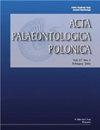两种泥盆纪肺鱼的幼体发育和神经颅骨骨化
IF 1.9
3区 地球科学
Q2 PALEONTOLOGY
引用次数: 0
摘要
肺鱼是为数不多的早期脊椎动物分支之一,拥有丰富的4.1亿年前的化石记录。肺鱼的特点是低进化率,被认为是自晚泥盆世以来与幼体发育有关。肺鱼的发育趋势包括中间鳍的数量减少,颅骨真皮骨的数量减少,神经颅骨骨化程度降低。这种神经颅骨特征从泥盆纪物种的高度骨化进化到泥盆纪后物种的完全软骨化。为了更好地理解幼体发育在肺鱼进化过程中的驱动作用,需要研究泥盆纪肺鱼的神经颅脑状况。对两个泥盆纪物种scaumenecia curta(中Frasnian, Escuminac组,加拿大东部)和Pentlandia macroptera (Givetian, Orcadian Basin,苏格兰)的神经颅骨进行了显微ct扫描。这些物种被认为像其他“平胸膜类”和“fleurantid”一样有一个软骨状的神经头盖骨。幼鱼(或亚成虫)和成虫标本具有软骨性的神经颅骨,而现在认为大翅大蠊的神经颅骨骨化程度较低。黄铁矿填充的神经颅腔保留了一些颅内结构(如嗅球、半圆形管),使我们能够对黄刺草的系统发育特征进行编码。这种独特的保存方式表明,有时黄铁矿是一种防腐剂,而不是一种破坏性的成岩剂。在Pentlandia和scaumencia之间的进化间隙,幼体发育已经导致神经颅骨骨化减少,而颅骨真皮骨变化不大。本文章由计算机程序翻译,如有差异,请以英文原文为准。
Paedomorphosis and neurocranial ossification in two Devonian lungfishes
Lungfishes are one of the few early vertebrate clades with a rich 410-million-years-old fossil record. Lungfishes are characterized by a low evolutionary rate assumed to be associated with paedomorphosis since the Late Devonian. Lungfish paedomorphic trends include a reduction of the number of median fins, reduction of the number of cranial dermal bones, and reduction of the degree of neurocranial ossification. This neurocranial trait has evolved from heavily ossified in Devonian species to completely cartilaginous in post-Devonian species. Neurocranial conditions among derived Devonian lungfishes are needed to have a better understanding of paedomorphosis as a driving force during lungfish evolution. The neurocrania of two Devonian species, Scaumenacia curta (middle Frasnian, Escuminac Formation, eastern Canada) and Pentlandia macroptera (Givetian, Orcadian Basin, Scotland), have been micro-CT-scanned. These species were assumed to have a cartilaginous neurocranium like other “phaneropleurids” and “fleurantids”. Juvenile (or sub-adult) and adult specimens of S. curta possess cartilaginous neurocrania, whereas P. macroptera is now recognized to have a poorly ossified neurocranium. Pyrite filled neurocranial cavities preserving some endocranial structures (e.g., olfactory bulbs, semicircular canals) allow us to code for phylogenetic endocranial characters in S. curta. This unique mode of preservation suggests that occasionally pyrite is a preservative rather than a destructive diagenetic agent. In the evolutionary gap between Pentlandia and Scaumenacia, paedomorphosis had already resulted in reduction of neurocranial ossification while little changes occurred in cranial dermal bones.
求助全文
通过发布文献求助,成功后即可免费获取论文全文。
去求助
来源期刊

Acta Palaeontologica Polonica
地学-古生物学
CiteScore
2.80
自引率
5.60%
发文量
36
审稿时长
12.5 months
期刊介绍:
Acta Palaeontologica Polonica is an international quarterly journal publishing papers of general interest from all areas of paleontology. Since its founding by Roman Kozłowski in 1956, various currents of modern paleontology have been represented in the contents of the journal, especially those rooted in biologically oriented paleontology, an area he helped establish.
In-depth studies of all kinds of fossils, of the mode of life of ancient organisms and structure of their skeletons are welcome, as those offering stratigraphically ordered evidence of evolution. Work on vertebrates and applications of fossil evidence to developmental studies, both ontogeny and astogeny of clonal organisms, have a long tradition in our journal. Evolution of the biosphere and its ecosystems, as inferred from geochemical evidence, has also been the focus of studies published in the journal.
 求助内容:
求助内容: 应助结果提醒方式:
应助结果提醒方式:


